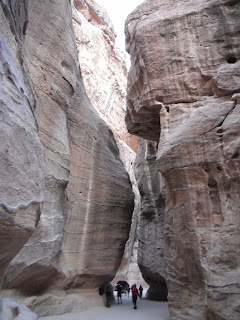Today we started in Petra. This old city was considered to be
lost for thousands of years after it was abandoned before it was found in the
1800’s. This city was important because it was on one of the main trade routes into
and through this region. Many caravans from all over the known world would pass
through the area carrying spices and other goods from the west to the coast in
Gaza. There are carvings in the walls along the road entering Petra showing a
caravan of camels being led.
 |
| spices and incense in a shop - the stuff that looks like amber is frankincense |
Tucked
away in the middle of the desert it is surprising to find such a well preserved
city and one of such size. Water for the city was collected with aqueducts and
stored to be used by the city. Being cut into the steep rocks of the wadi seems
to provide it with a little more protection from the elements as well. Most
impressive part of Petra is the buildings and caves that are carved into the
rocks at Petra. The most famous one is the ‘treasury’ that is located as you
come into the city. Although it never has (except in Indiana Jones) held
treasures, it is commonly called the treasury.
 |
| Carving of camel caravan, merchants feet |
 |
| camel feet |
 |
| 'treasury' |
 |
| a couple camels |
The Monastery is also quite
impressive. Located a little further up, apparently 850 steps, and tuck behind hills
it is a spectacular view. Nearby there is also a lookout that looks out over
the rift valley. It is from here, the city of Petra, which the traders would
make their trek westwards to get to Egypt or to the ports in Gaza.
 |
| hike up to the monestary |
 |
| looking out over the rift valley |
 |
| the treasury after the sun rose a little more |
In the afternoon we went to the site
of Bozrah. It was another city that was there because of the trade routes
coming from the East and cutting into the land of Israel. This was in the land
of Edom. This land is talked about throughout the Old Testament as the
descendants of Esau lived out here. Out here is where the rain shadow is
tapering off into nothing and the land provided barely enough to get by on.
It has occurred to me over the past
couple of days that this land is made up of many different groups of people and
often people who just end up here. It isn’t an ideal land, it isn’t a land with
many resources or easy access to anything, rather it is a land where there is
just enough to get by.
This land was filled with the
Israelites who asked to stay on this side of the Jordan. It was frequented with retreating kings and
desert wanders. This land was the land given to the brother who sold his
birth-rite and sons of Lot who chose the ‘greener’ land. This land has boarders
that shift with the weather and hemmed in by the desert. They have figured out
how to survive and even thrive in a land that lacks.
 |
| the children seemed excited to welcome us when we got to the hotel |
Even today this land is frequented by
those who ‘don’t belong’. A good portion of the population of Jordan is made up
of Palestinians who left Israel during the war there as refugees. Today there
are over three million Syrian refugees who have left Syria due to the fight
there. While we were in the North I noticed that there were quite a few tents
that had the UN symbol on them that looked like refugee tents.
 |
| a refugee tent in between buildings in Pehel |
Israel is located just across the
rift valley, although it is a national border today, it has seemed to have been
a major connecting point between the two regions in the past. Maybe God placed
his children in a place so close to the people on the other side, the people
that seemed almost related to Israel (Ammonites and Moabites come from Lot,
Edomites from Esau) so that they could have the opportunity to bless all
nations, maybe starting with them.
Maybe the love and justice that we
are suppose to bless all nations with starts with loving the estranged brother.





















We've been learning about Bozra, it is mentioned in prophecy. Israel may be going there during the second half of the tribulation
ReplyDelete